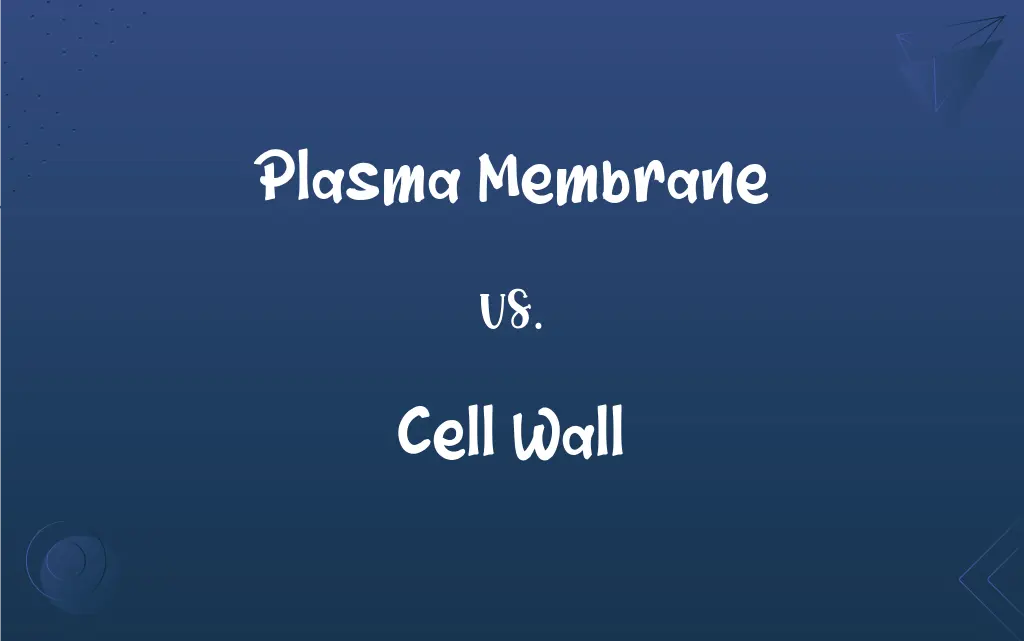Plasma Membrane vs. Cell Wall: What's the Difference?
Edited by Aimie Carlson || By Harlon Moss || Updated on October 19, 2023
The plasma membrane is a thin, flexible barrier surrounding all cells, while the cell wall is a rigid, protective layer found mainly in plant cells.

Key Differences
The plasma membrane, also known as the cell membrane, is a fundamental component of all living cells, whether they are plant, animal, fungal, or bacterial. Comprised primarily of lipids and proteins, it acts as a selective barrier that regulates the passage of substances in and out of the cell. On the other hand, the cell wall is an additional protective and structural layer found outside the plasma membrane in certain organisms like plants, fungi, and some bacteria.
The plasma membrane's primary function is to maintain the cell's homeostasis by controlling the movement of molecules such as ions, nutrients, and waste products. It achieves this selectivity through a variety of protein channels and transporters embedded in its lipid bilayer structure. The cell wall, conversely, provides structural support to the cell, helping it maintain shape and resist internal and external pressures.
One distinguishing feature of the plasma membrane is its dynamic nature. This fluid mosaic of lipids and proteins can self-heal, fuse with other membranes, and engage in endocytosis and exocytosis. The cell wall lacks this fluidity; instead, it offers rigidity due to components like cellulose in plants or chitin in fungi.
Both the plasma membrane and cell wall have their unique significance. The plasma membrane's flexibility and selectivity are vital for cell signaling, nutrient uptake, and waste expulsion. In contrast, the cell wall's sturdiness is essential for protection against environmental stresses and provides mechanical strength to plants, aiding them in standing upright.
Comparison Chart
Primary Composition
Lipids and proteins
Cellulose (plants), chitin (fungi), peptidoglycan (bacteria)
ADVERTISEMENT
Location
Present in all cells
Mostly in plants, fungi, and some bacteria
Function
Regulates substance transport, cell signaling
Provides rigidity, protection, and structural support
Physical Characteristics
Flexible, dynamic
Rigid, static
Response to Environment
Engages in endocytosis and exocytosis
Offers protection against environmental stresses
Plasma Membrane and Cell Wall Definitions
Plasma Membrane
A lipid bilayer that encloses cellular contents.
The plasma membrane controls the movement of ions in and out of the cell.
ADVERTISEMENT
Cell Wall
A protective barrier made of complex carbohydrates.
Cellulose in the cell wall provides strength to plant cells.
Plasma Membrane
The outermost boundary of animal cells.
The plasma membrane maintains the cell's internal environment.
Cell Wall
A layer outside the plasma membrane in certain organisms.
The presence of a cell wall distinguishes plant cells from animal cells.
Plasma Membrane
A protective layer with selective permeability.
The plasma membrane ensures toxins remain outside the cell.
Cell Wall
A non-flexible component determining cell shape.
Bacteria with a thicker cell wall are more resistant to certain antibiotics.
Plasma Membrane
The cell's selective barrier.
Oxygen and nutrients pass through the plasma membrane to enter the cell.
Cell Wall
A rigid outer layer in plants, fungi, and some bacteria.
The cell wall gives plants their structural support.
Plasma Membrane
A dynamic layer of lipids and proteins.
Receptor proteins in the plasma membrane help in cell signaling.
Cell Wall
An external structure providing shape and support.
The cell wall prevents plant cells from bursting when they take in water.
FAQs
What is the primary component of the plant cell wall?
The primary component is cellulose.
Is the cell wall present in animal cells?
No, animal cells lack a cell wall; they only have a plasma membrane.
What is the main function of the plasma membrane?
The plasma membrane regulates the transport of substances in and out of the cell.
Do algae have a cell wall?
Yes, many algae have cell walls made of various polysaccharides.
Are plasma membranes the same in all cells?
While they share a basic structure, their protein and lipid composition can vary.
Is the cell wall permeable to substances?
It is permeable but doesn't regulate transport like the plasma membrane.
Why is the cell wall important for plants?
It provides structural support, protection, and helps maintain cell shape.
How do cells communicate through the plasma membrane?
Through receptor proteins that receive signals from outside the cell.
What happens when the cell wall is compromised?
Cells can become more susceptible to environmental stresses and may lose shape.
What organisms typically have a chitin-based cell wall?
Fungi have cell walls made of chitin.
How does the plasma membrane maintain cell homeostasis?
Through selective permeability, allowing specific substances to enter or exit.
What gives the plasma membrane its fluid nature?
The lipid bilayer with embedded proteins allows for flexibility.
Do any cells lack a plasma membrane?
No, all living cells have a plasma membrane.
Are plasma membranes unique to eukaryotic cells?
No, both eukaryotic and prokaryotic cells have plasma membranes.
How do substances move across the plasma membrane?
Through passive or active transport, facilitated by protein channels.
Can the cell wall regulate substance transport like the plasma membrane?
No, its primary function is structural support, not selectivity.
Do all bacteria have a cell wall?
Most do, typically made of peptidoglycan.
Can the cell wall adapt to environmental changes?
It can modify its composition, but it remains rigid compared to the plasma membrane.
How does cholesterol affect the plasma membrane?
Cholesterol helps maintain membrane fluidity and stability.
Can the plasma membrane repair itself?
Yes, it has self-healing capabilities due to its lipid bilayer structure.
About Author
Written by
Harlon MossHarlon is a seasoned quality moderator and accomplished content writer for Difference Wiki. An alumnus of the prestigious University of California, he earned his degree in Computer Science. Leveraging his academic background, Harlon brings a meticulous and informed perspective to his work, ensuring content accuracy and excellence.
Edited by
Aimie CarlsonAimie Carlson, holding a master's degree in English literature, is a fervent English language enthusiast. She lends her writing talents to Difference Wiki, a prominent website that specializes in comparisons, offering readers insightful analyses that both captivate and inform.































































